Click here for blog entry notification
Sitting on the porch of the Peake Ranch casita in the fading day of rain showers and the longer day light hours of daylight savings time. Nice deal.
We have been getting occasional rain today and more is predicted. The rain replenishes our soil moisture but soil can only hold so much water no matter how much it rains. It may be hard for those who pay attention to the rain in California to believe but our soil moisture gauges show as much or more water in the soil as we had at this time in rainy 2017. This is a really good way to start the season.
Speaking of the season start, the vines are beginning to grow! The buds are fuzzy as they expand (we say push) and soon we will have leaves and clusters and before we know it harvest. Ok, a little ahead of myself but we are very excited.
Today’s picture is bud push at John Sebastiano Vineyard.
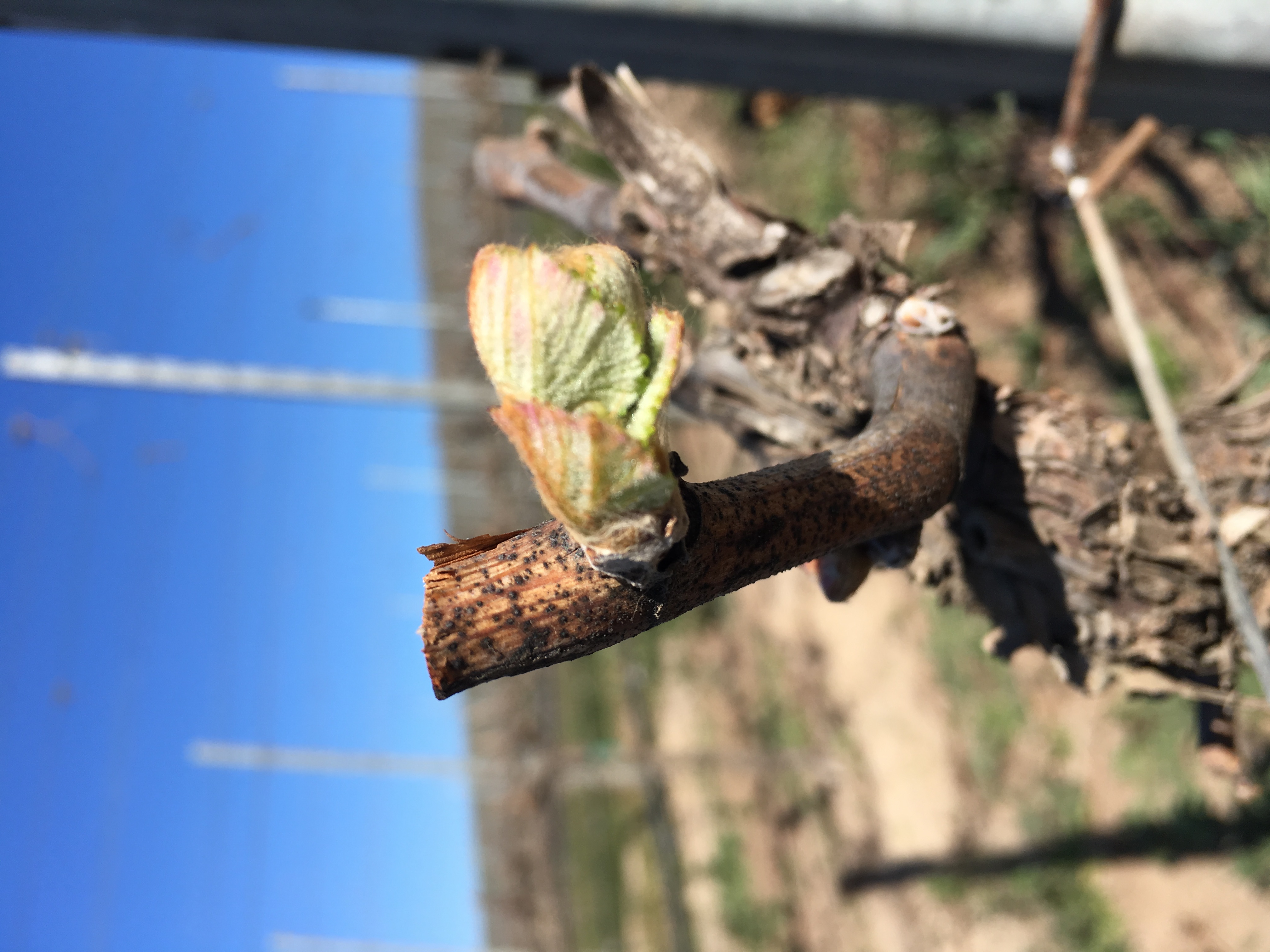
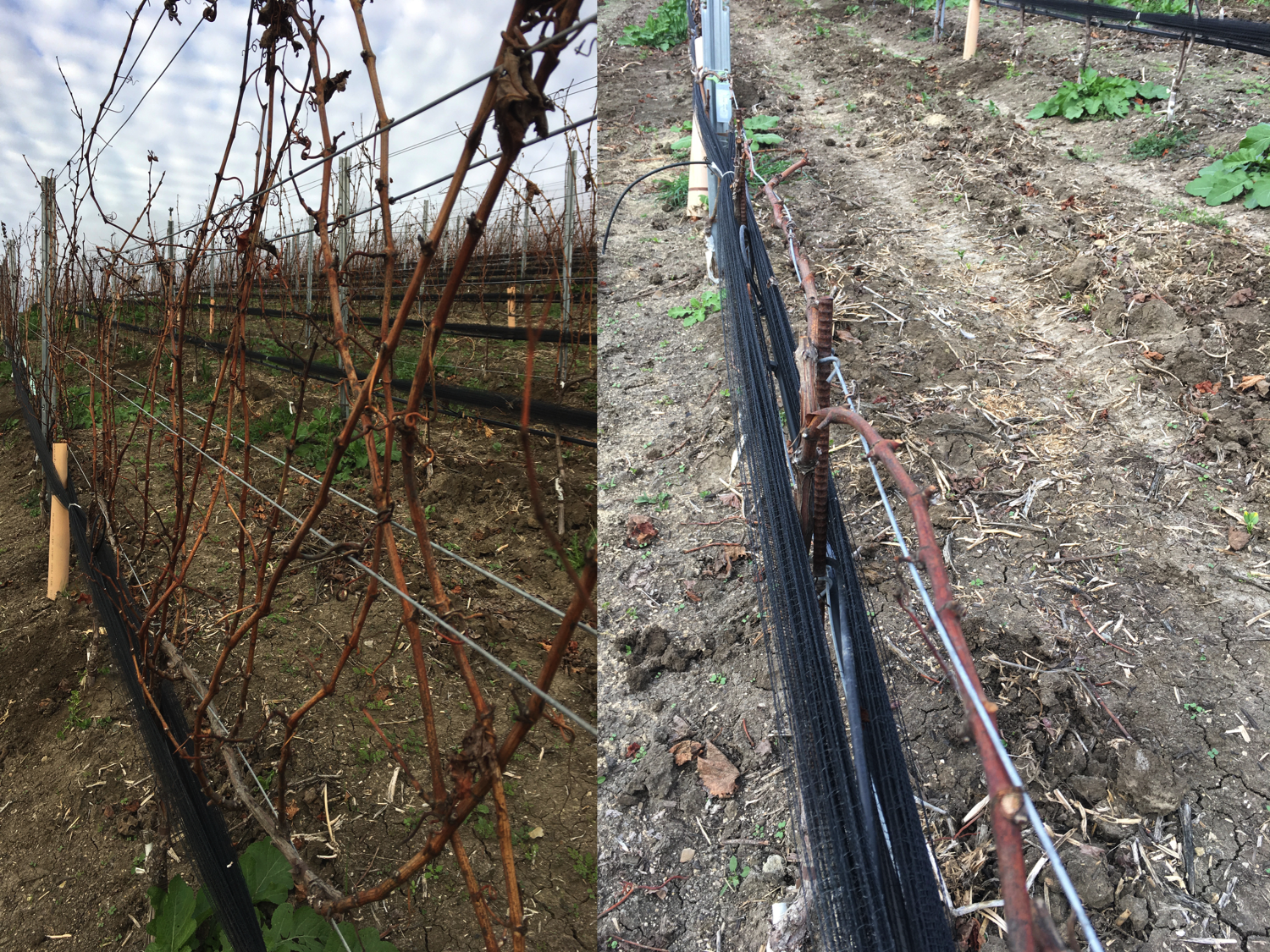
 Hello again and apologies. “I been gone too long”. I am back now and will resume a regular dialog.
Hello again and apologies. “I been gone too long”. I am back now and will resume a regular dialog.
It has been awhile since harvest and winter was supposed to be here but it hasn’t shown up yet. Two days ago we made it to 83 degrees F and we will probably make it to 80 today.
We are pruning our vines as fast as we can. Grapevines, being perennial, do not have a beginning and end of their growth cycle but I always feel pruning is the beginning. It is now that we try to regulate to the growth and fruit we will see in the coming season. TRY. Because of the forward thinking required it is full of hope. “if we cut this then that will happen and then next year we will have this to work with’.
Pruning grapevines is different than pruning most other fruiting perennials. We actually remove ~95% of the past year’s growth. This is an extraordinary amount of pruning. Try imagining removing 95% of your apple tree every year.
All is good and even though we do not expect it to be 80 degrees we have little to do about it but to enjoy the sun and fill our heads with the hope of a great 2018.
Today’s pictures include before and after pruning accompanied by a photo of the pruners at work.

We have made it to the midpoint of harvest in volume but not time. The last ones to pick are sure to dribble out over some weeks. Even with that statistical fact, it in no way feels like the end of the tunnel. It is hard to see the light when you are a picker in the vineyard at 12am every morning and have to pick fruit for the next 8-10 hours. Hard to see very far into the future.
To make matters even more difficult, we just went through the hottest period of the year at Peake Ranch (an extremely hot period regardless of the year) with a high temperature of 108 degrees F reached yesterday (2 Sept) followed by a low that was still above 70 degrees. Thankfully, the humidity also dropped so it was a “dry heat”. Still very uncomfortable for humans.
We carefully monitor many things in our vineyards to provide better understanding of the effects of the environment on the vines and fruit. With this information we can fine-tune many of our actions. Of course, this data only tells us what is happening and has happened, not what will. I would be great to have that data! Here are figures describing the heat event of the last several days.
See you soon.
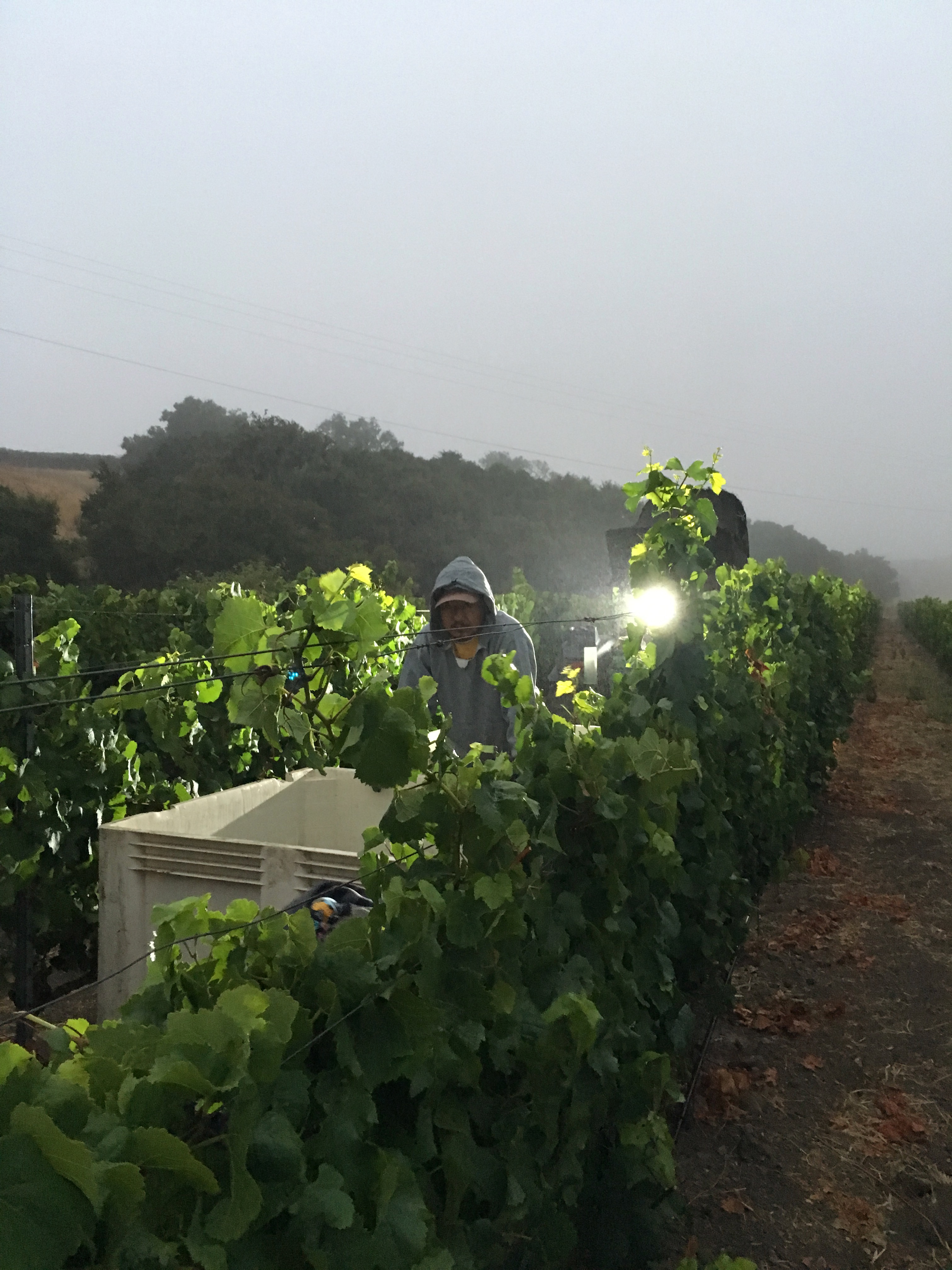
As the first light of last Saturday showed over the hill we were already beginning the 2017 harvest! We harvested Pinot noir at JSV for a rosé wine. Grapes for rosé are most commonly picked well before grapes from the same variety that are destined for red wine. The result is something more subtle, higher in acid and lower in alcohol. An absolutely delightful product. For reference, we can look back at a previous edition of this blog (Managing Birds) and see that winemakers start picking grapes for red wine at about 25% sugar in contrast, these rosé destined grapes had juice containing about 21% sugar. That may not sound like that big a difference but it is and there are other components of juice chemistry that are also very different. The rosé is closer in chemistry and style to white wine that it is to its red brother.
So we are off to the races. This time of year is exciting in its intensity but the intensity is also exhausting. At this point we are filled with excitement to see to product we worked on all season at the finish line. That feeling will fade with exhaustion.
I'm glad to see you coming, I'm glad to see you go, She once told me
Jimmie Dale Gilmore
Most probably there will be a future blog about being happy we are done
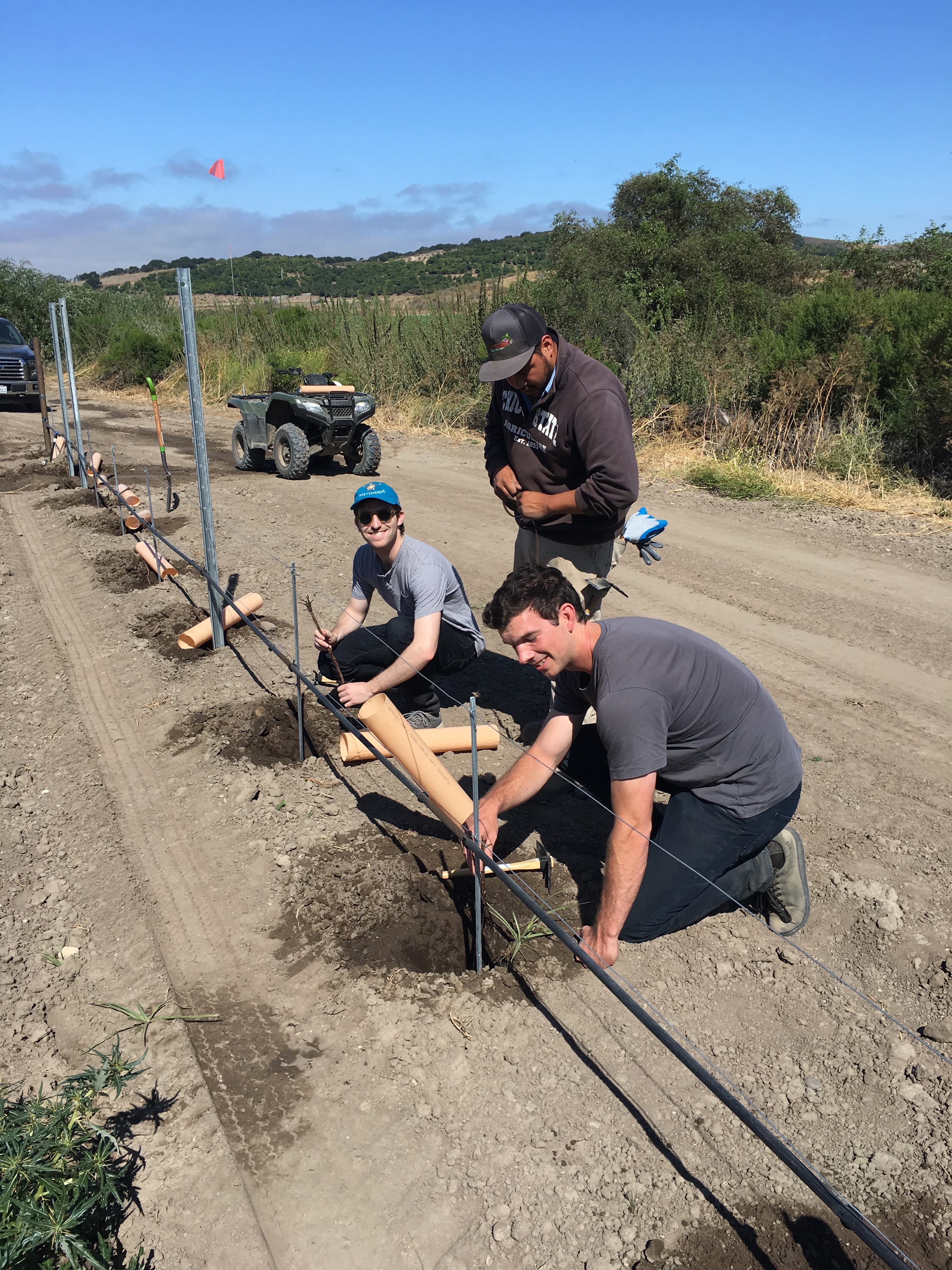
Over the past weekend we had “agri tourists” Tom Wagner (John and Gill’s son) and his long time friend Jeremy Gold. We spent a good deal of time bouncing around in the truck and walking in vineyards with Daisy and Emily. Much of the conversation centered around what I will refer to as “smart farming” which pretty much comes down to keeping your mind open and availing yourself of knowledge. For instance, we have some vines that are extremely unhappy and after exhausting our own knowledge we invited Dr. Mysore Sudarshana, USDA Plant Pathologist from UC Davis, to visit us. He came down last week with three members of his lab and went to work collecting samples in pursuit of answers. We had a great time together and shared ideas far beyond the question of the day. Smart Farming and good times. In the week prior to that we had members of The Vineyard Team preform an evaluation of the drip irrigation system at Peake (we have work to do) as a possible place we could work on increasing the uniformity of the vineyard. These were the sort of subjects Tom, Jeremy and I discussed. They both were open minded and extremely interested, making it a great time for all three of us. Perhaps we are cultivating our successors.
Toward the end of the day we met up with vineyard manager Fidencio Flores at a new vineyard to plant the ceremonial first vines. I little work to go with the talk.
Today’s picture is of Tom and Jeremy planting vines under the watchful eye of Fidencio. Steady now, I know where the vines you planted are!

Remember that part of veraison that begins ripening in general and includes the influx of sugar to the berry? Sugar content of the juice goes from approximately 0 preveraison, to about 25% (a winemaker decision) at harvest. To put that in perspective, a can of cola is about 10% sugar.
So, the grapes kind of taste good to us humans that tend to like sweet. Why not, it is fast energy. Turns out (and for the same reason), we are not the only animals that like sugar. BIRDS, in particular, like the sugary grapes and set their sights on the grapes as soon as they begin to color and accumulate sugar. [Actually this is the whole idea behind the grape putting sugar in the berry. The vine is hoping the sweet berries will attract the birds, the birds will eat the fruit and deposit the seeds elsewhere thus expanding the range of the species. We humans are actually disrupting the natural intent and design. Wine was never part of the plan.] If we feed the birds there will be less if not zero wine. What to do?
There are many approaches tried, recorded bird distress calls, sonic cannons, glittering strands of reflective tape, balloons that look like predators, on and on. Usually, after a couple days, the birds figure out that all those things are not harmful and go back to their party. The only thing we have found that reliably works is the physical barrier of a net.
In today’s photo are Pinot noir grapes at Peake Ranch just after netting.

Last post I talked about imminent veraison, well here it is! Veraison doesn’t occur in all grapes at the same moment so we talk about % veraison – I am going to say this is 35%. There are 5 events through the season that mark significant signposts on the road to harvest. These are known as phenologic (the study of cyclic natural phenomena) events. We mark with great interest budbreak, bloom, berry set, veraison and harvest. Veraison is easiest to see in red pigmented grapes (it, of course, also occurs in white fruit but it is a little harder to see) such as these Pinot noir at John Sebastiano Vineyard. As I discussed previously, not only is there the change in color but an immediate influx of sugar to the grape – we are now on the way to harvest! Winemakers begin to take more interest in the vineyard and the grapes are already edible (a bit tart though). We will choose a couple blocks next week to monitor for this chronicle to follow to harvest. Gonna be fun.
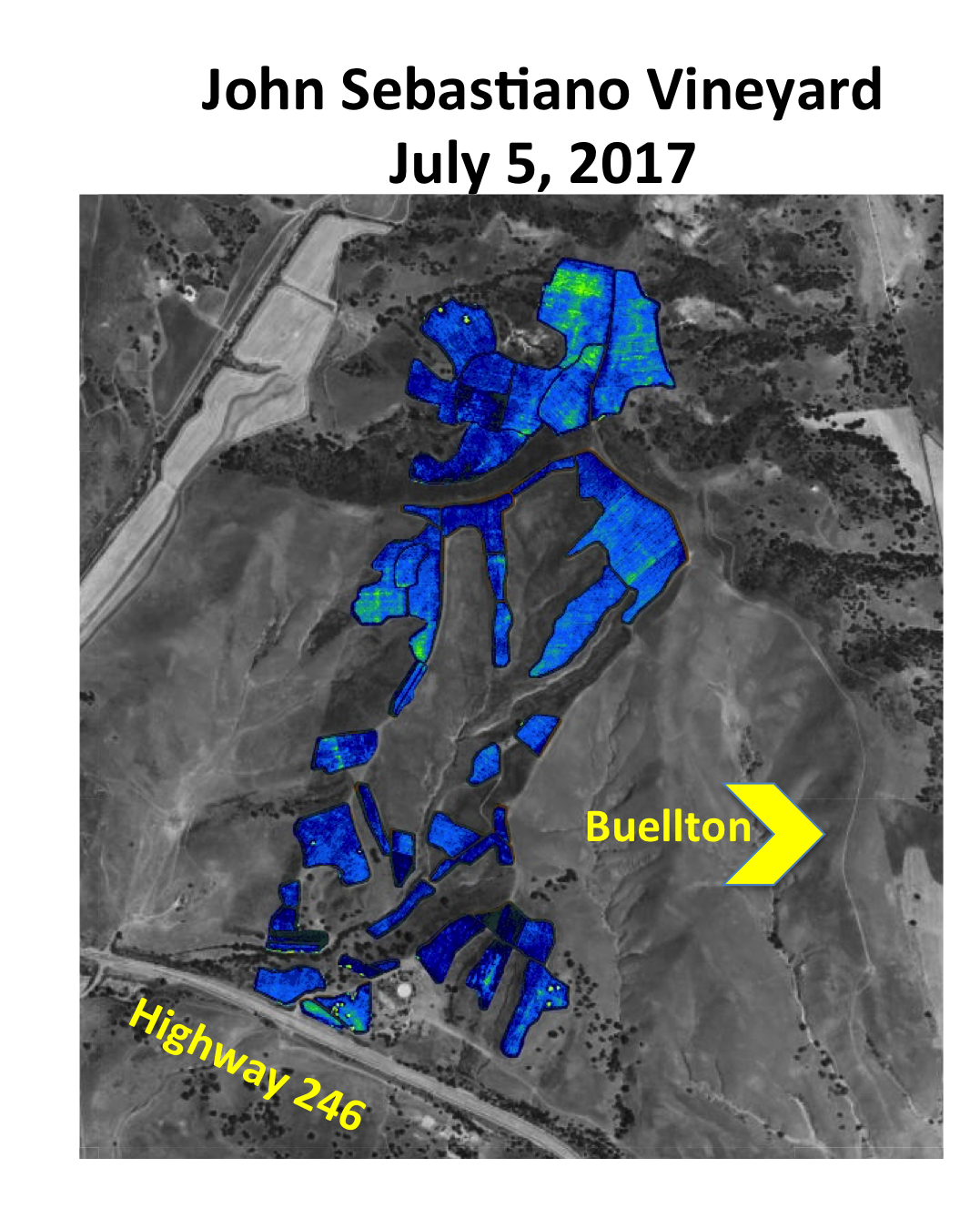
On my side of the winemaking equation is the requirement to produce the best grapes from our vineyard sites. This can be a complicated process on sites that differ block-to-block and even within blocks. As in all endeavors we learn from the past AND we hope to contribute knowledge that moves our skill ever forward. While there is no substitute for the time-honored practice of boots on the ground we can add to that with new technologies. Today’s image is an aerial photo of the John Sebastiano Vineyard. First notice how complicated the layout of the individual blocks is, just the physical part of visiting every block is a huge task. Data for the image is collected that allows the analysis of individual wavelengths that can be processed to produce what you see here. This image shows a vegetative index (seen as a range of colors) that lets us know where vines are growing larger and smaller. With this information we can identify areas of concern and fine-tune our visual inspections. Modern technology assisting and adding to tradition.
I am using this first post as an introduction. Hello, I am Mike Anderson and you can see my info elsewhere on this website so no reason to spend much time on that. In a nutshell I shepherd the grapes to the winery. My partner in this effort is Emily. Emily was rescued from a South Korean dog farm where she was “on the menu”. She has been with me for a year and a half and is a great vineyard dog / campanion. She is currently interviewing for a job as Daisy’s assistant. We will see, Daisy is picky about her help.
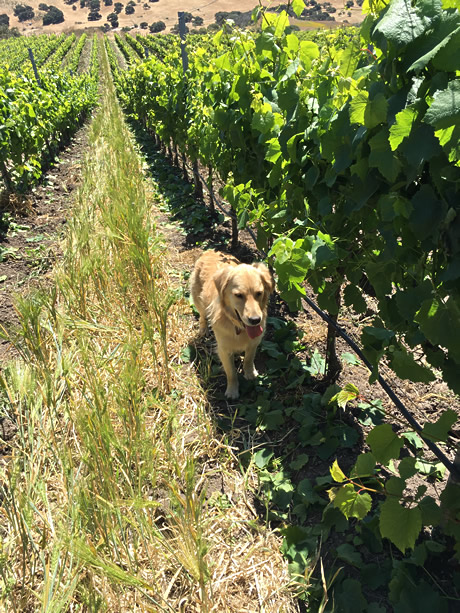
As we enter July I see the vines in very good shape with a moderate crop. The welcome and heavy rainfall we received last winter got the vines off to a very good start and that has had continued benifits. We are now close to entering veraison. This is a viticultural term that indicates the onset of sugar accumulation in the berries (ripening). At veraison the vine shifts its focus from growing vegetation to putting sugar in the fruit. A celebration for the birds and us! This blog will be chronicling the process with regular posts.
Questions and comments are welcome in the comments section below.
For now, good to meet you and I will see you soon.